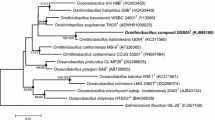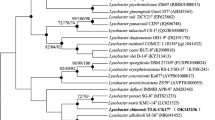Abstract
A Gram-negative, motile, rod-shaped, endospore-forming bacterial strain, designated as NCCP-36T, was isolated from the compost of fruit and vegetable wastes. The strain NCCP-36T grew within a temperature range of 10–45 ○C (optimum 28 ○C) and a pH range of 6.5–8.5 (optimum 7.0), and its cells tolerated <50 mM boron (optimum growth without boron) and 0–5 % NaCl (w/v) in tryptic soya broth medium. Based on comparative analysis of 16S rRNA gene sequence, strain NCCP-36T showed the highest similarity to Lysinibacillus sinduriensis BLB-1T (97.52 %) and L. xylanilyticus XDB9T (96.96 %), and <97 % similarity with other closely related taxa. However, DNA–DNA relatedness between strain NCCP-36T and the closely related type strains of genus Lysinibacillus was ≤37 %. Phylogenetic and chemotaxonomic analyses [major polar lipids: diphosphatidylglycerol, phosphatidylglycerol, phosphatidylethanolamine, and phospholipids; predominant menaquinone: MK-7; major cellular fatty acids: iso-C15:0, antieso-C15:0, and iso-C16:0; DNA G+C contents: 37 mol %; Lys-Asp (type A4α) in cell-wall peptidoglycans as diagnostic amino acids] also support the affiliation of strain NCCP-36T to genus Lysinibacillus. Based upon DNA–DNA relatedness as well as distinctive chemotaxonomic, phylogenetic, and genotypic data, we conclude that strain NCCP-36T belongs to a novel species of genus Lysinibacillus, for which the name Lysinibacillus composti sp. nov. is proposed. The type strain is NCCP-36T (JCM 18777T = KCTC 13796T = DSMZ 24785T).

Similar content being viewed by others
References
Ahmed I, Yokota A, Fujiwara T (2007a) A novel highly boron tolerant bacterium, Bacillus boroniphilus sp. nov., isolated from soil, that requires boron for its growth. Extremophiles 11:217–224
Ahmed I, Yokota A, Yamazoe A, Fujiwara T (2007b) Proposal of Lysinibacillus boronitolerans gen. nov sp nov., and transfer of Bacillus fusiformis to Lysinibacillus fusiformis comb. nov and Bacillus sphaericus to Lysinibacillus sphaericus comb. nov. Int J Syst Evol Microbiol 57:1117–1125. doi:10.1099/ijs.0.63867-0
Albert RA, Archambault J, Lempa M, Hurst B, Richardson C, Gruenloh S, Duran M, Worliczek HL, Huber BE, Rossello-Mora R, Schumann P, Busse HJ (2007) Proposal of Viridibacillus gen. nov. and reclassification of Bacillus arvi, Bacillus arenosi and Bacillus neidei as Viridibacillus arvi gen. nov., comb. nov., Viridibacillus arenosi comb. nov. and Viridibacillus neidei comb. nov. Int J Syst Evol Microbiol 57(12):2729–2737. doi:10.1099/ijs.0.65256-0
Ash C, Farrow JAE, Wallbanks S, Collins MD (1991) Phylogenetic heterogeneity of the genus Bacillus revealed by comparative analysis of small-subunit-ribosomal RNA sequences. Lett Appl Microbiol 13(4):202–206. doi:10.1111/j.1472-765X.1991.tb00608.x
Ash C, Priest FG, Collins MD (1993) Molecular identification of rRNA group 3 bacilli (Ash, Farrow, Wallbanks and Collins) using a PCR probe test. Proposal for the creation of a new genus Paenibacillus. Antonie Van Leeuwenhoek 64(3–4):253–260
Chang YH, Han JI, Chun JS, Lee KC, Rhee MS, Kim YB, Bae KS (2002) Comamonas koreensis sp. nov., a non-motile species from wetland in Woopo, Korea. Int J Syst Evol Microbiol 52:377–381. doi:10.1099/ijs.0.01734-0
Chang YH, Jung MY, Park IS, Oh HM (2008) Sporolactobacillus vineae sp nov., a spore-forming lactic acid bacterium isolated from vineyard soil. Int J Syst Evol Microbiol 58:2316–2320. doi:10.1099/ijs.0.65608-0
Claus D, Berkeley RCW (1986) Genus Bacillus Cohn. In: Vos P, Garrity G, Jones D, Krieg NR, Ludwig W, Rainey FA, Schleifer K-H, Whitman WB (eds) Bergey’s manual systematic bacteriology, vol 3: The firmicutes. Williams & Wilkins, Baltimore, pp 1105–1139
Coorevits A, Dinsdale AE, Heyrman J, Schumann P, Van Landschoot A, Logan NA, De Vos P (2012) Lysinibacillus macroides sp. nov., nom. rev. Int J Syst Evol Microbiol 62(5):1121–1127. doi:10.1099/ijs.0.027995-0
Ezaki T, Hashimoto Y, Yabuuchi E (1989) Fluorometric deoxyribonucleic acid-deoxyribonucleic acid hybridization in microdilution wells as an alternative to membrane filter hybridization in which radioisotopes are used to determine genetic relatedness among bacterial strains. Int J Syst Bacteriol 39:224–229
Farrow JAE, Wallbanks S, Collins MD (1994) Phylogenetic interrelationships of round-spore-forming bacilli containing cell-walls based on lysine and the non-spore-forming genera Caryophanon, Exiguobacterium, Kurthia, and Planococcus. Int J Syst Bacteriol 44(1):74–82
Felsenstein J (2005) PHYLIP (Phylogeny Inference Package). Version 3.6. distributed by the author. Department of Genome Sciences, University of Washington, Seattle
Glazunova OO, Raoult D, Roux V (2006) Bacillus massiliensis sp. nov., isolated from cerebrospinal fluid. Int J Syst Evol Microbiol 56(Pt 7):1485–1488. doi:10.1099/ijs.0.63982-0
Hayat R, Ahmed I, Paek J, Ehsan M, Iqbal M, Chang YH (2013) A moderately boron-tolerant candidatus novel soil bacterium Lysinibacillus pakistanensis sp. nov. cand., isolated from soybean (Glycine max L.) rhizosphere. Pak J Bot 45(S1):41–50
Heyndrickx M, Lebbe L, Kersters K, De Vos P, Forsyth C, Logan NA (1998) Virgibacillus: a new genus to accommodate Bacillus pantothenticus (Proom and Knight 1950). Emended description of Virgibacillus pantothenticus. Int J Syst Bacteriol 48:99–106
Jung MY, Kim J-S, Paek WK, Styrak I, Park I-S, Sin Y, Paek J, Park KA, Kim H, Kim HL, Chang Y-H (2012) Description of Lysinibacillus sinduriensis sp. nov., and transfer of Bacillus massiliensis and Bacillus odysseyi to the genus Lysinibacillus as Lysinibacillus massiliensis comb. nov. and Lysinibacillus odysseyi comb. nov. with emended description of the genus Lysinibacillus. Int J Syst Evol Microbiol 62(10):2347–2355. doi:10.1099/ijs.0.033837-0
Kämpfer P, Rossello-Mora R, Falsen E, Busse HJ, Tindall BJ (2006) Cohnella thermotolerans gen. nov., sp. nov., and classification of 'Paenibacillus hongkongensis' as Cohnella hongkongensis sp. nov. Int J Syst Evol Microbiol 56:781–786. doi:10.1099/ijs.0.63985-0
Kämpfer P, Martin K, Glaeser SP (2013) Lysinibacillus contaminans sp. nov., isolated from a surface water. Int J Syst Evol Microbiol. doi:10.1099/ijs.0.049593-0
Kawamoto I, Oka T, Nara T (1981) Cell-wall composition of Micromonospora olivoasterospora, Micromonospora agamiensis, and related organisms. J Bacteriol 146(2):527–534
Krishnamurthi S, Chakrabarti T, Stackebrand E (2009) Re-examination of the taxonomic position of Bacillus silvestris Rheims et al. 1999 and proposal to transfer it to Solibacillus gen. nov as Solibacillus silvestris comb. nov. Int J Syst Evol Microbiol 59:1054–1058. doi:10.1099/ijs.0.65742-0
La Duc MT, Satomi M, Venkateswaran K (2004) Bacillus odysseyi sp. nov., a round-spore-forming bacillus isolated from the Mars Odyssey spacecraft. Int J Syst Evol Microbiol 54:195–201. doi:10.1099/Ijs.0.02747
Lee CS, Jung Y-T, Park S, Oh T-K, Yoon J-H (2010) Lysinibacillus xylanilyticus sp. nov., a xylan-degrading bacterium isolated from forest humus. Int J Syst Evol Microbiol 60(2):281–286. doi:10.1099/ijs.0.013367-0
Liu H, Song Y, Chen F, Zheng S, Wang G (2013) Lysinibacillus manganicus sp. nov., isolated from manganese mining soil. Int J Syst Evol Microbiol. doi:10.1099/ijs.0.050492-0
Logan NA, Berge O, Bishop AH, Busse HJ, De Vos P, Fritze D, Heyndrickx M, Kampfer P, Rabinovitch L, Salkinoja-Salonen MS, Seldin L, Ventosa A (2009) Proposed minimal standards for describing new taxa of aerobic, endospore-forming bacteria. Int J Syst Evol Microbiol 59(8):2114–2121. doi:10.1099/ijs.0.013649-0
Marmur J (1963) A procedure for the isolation of deoxyribonucleic acid from microorganisms. Method Enzymol 6:726–738. doi:10.1016/0076-6879(63)06240-6
Mesbah M, Premachandran U, Whitman WB (1989) Precise measurement of the G+C content of deoxyribonucleic-acid by high-performance liquid-chromatography. Int J Syst Bacteriol 39(2):159–167
Miwa H, Ahmed I, Yokota A, Fujiwara T (2009) Lysinibacillus parviboronicapiens sp nov., a low-boron-containing bacterium isolated from soil. Int J Syst Evol Microbiol 59:1427–1432. doi:10.1099/ijs.0.65455-0
Priest FG, Goodfellow M, Todd C (1988) A numerical classification of the genus Bacillus. J Gen Microbiol 134:1847–1882
Rheims H, Fruhling A, Schumann P, Rohde M, Stackebrandt E (1999) Bacillus silvestris sp. nov., a new member of the genus Bacillus that contains lysine in its cell wall. Int J Syst Bacteriol 49:795–802
Roohi A, Ahmed I, Iqbal M, Jamil M (2012) Preliminary isolation and characterization of halotolerant and halophilic bacteria from salt mines of Karak, Pakistan. Pak J Bot 44(SI 1):365–370
Schleifer KH, Kandler O (1972) Peptidoglycan types of bacterial cell walls and their taxonomic implications. Bacteriol Rev 36(4):407–477
Seiler H, Scherer S, Wenning M (2013) Lysinibacillus meyeri sp. nov., isolated from a medical practice. Int J Syst Evol Microbiol 63(Pt 4):1512–1518. doi:10.1099/ijs.0.039420-0
Shida O, Takagi H, Kadowaki K, Komagata K (1996) Proposal for two new genera, Brevibacillus gen nov and Aneurinibacillus gen nov. Int J Syst Bacteriol 46(4):939–946
Stakebrandt E, Goebel BM (1994) Taxonomic note: a place for DNA–DNA reassociation and 16S rRNA sequence analysis in the present species definition in bacteriology. Int J Syst Evol Microbiol 44:846–849
Stackebrandt E, Swiderski J (2008) From phylogeny to systematics: the dissection of the genus Bacillus. In: Berkeley R, Heyndrickx M, Logan N, De Vos P (eds) Applications and systematics of Bacillus and relatives. Blackwell Science Ltd, Oxford, pp 8–22. doi:10.1002/9780470696743.ch2
Tamura K, Peterson D, Peterson N, Stecher G, Nei M, Kumar S (2011) MEGA5: Molecular evolutionary genetics analysis using maximum likelihood, evolutionary distance, and maximum parsimony methods. Mol Biol Evol 28:2731–2739. doi:10.1093/molbev/msr121
Tindall BJ (1990) A comparative-study of the lipid-composition of Halobacterium saccharovorum from various sources. Syst Appl Microbiol 13(2):128–130
Wainø M, Tindall BJ, Schumann P, Ingvorsenl K (1999) Gracilibacillus gen. nov., with description of Gracilibacillus halotolerans gen. nov., sp. nov. ; transfer of Bacillus dipsosauri to Gracilibacillus dipsosauri comb. nov., and Bacillus salexigens to the genus Salibacillus gen. nov., as Salibacillus salexigens comb. nov. Int J Syst Bacteriol 49:821–831
Wisotzkey JD, Jurtshuk P Jr, Fox GE, Deinhard G, Poralla K (1992) Comparative sequence analyses on the 16S rRNA (rDNA) of Bacillus acidocaldarius, Bacillus acidoterrestris, and Bacillus cycloheptanicus and proposal for creation of a new genus, Alicyclobacillus gen. nov. Int J Syst Bacteriol 42(2):263–269
Xie CH, Yokota A (2003) Phylogenetic analyses of Lampropedia hyalina based on the 16S rRNA gene sequence. J Gen Appl Microbiol 49(6):345–349. doi:10.2323/Jgam.49.345
Yang LL, Huang Y, Liu J, Ma L, Mo MH, Li WJ, Yang FX (2012) Lysinibacillus mangiferihumi sp. nov., a new bacterium producing nematicidal volatiles. Antonie Van Leeuwenhoek 102(1):53–59. doi:10.1007/s10482-012-9712-4
Yoon JH, Weiss N, Lee KC, Lee IS, Kang KH, Park YH (2001) Jeotgalibacillus alimentarius gen. nov., sp nov., a novel bacterium isolated from jeotgal with L-lysine in the cell wall, and reclassification of Bacillus marinus Ruger 1983 as Marinibacillus marinus gen. nov., comb. nov. Int J Syst Evol Microbiol 51:2087–2093
Zhang L, Xu Z, Patel BK (2007) Bacillus decisifrondis sp. nov., isolated from soil underlying decaying leaf foliage. Int J Syst Evol Microbiol 57(5):974–978. doi:10.1099/ijs.0.64440-0
Acknowledgments
We gratefully acknowledge the kind help of Dr. Takuji Kudo from JCM, Tsukuba, Japan in the analysis of cell-wall peptidoglycans. This work was partially supported by PSDP Project “Research for Agricultural Development Program (RADP)” funded by Pakistan Agricultural Research Council (PARC) and by the KRIBB Research Initiative Program funded by the Ministry of Education, Science and Technology, Republic of Korea. Initial funds for these studies were provided by the Higher Education Commission of Pakistan under talent training program for young faculty members for training at National Institute for Genomics and Advanced Biotechnology, NARC, Islamabad, Pakistan and also at the Institute of Molecular and Cellular Biosciences, The University of Tokyo, Bunkyo-ku, Tokyo, Japan.
Author information
Authors and Affiliations
Corresponding authors
Additional information
The DDBJ/EMBL/GenBank accession number for the 16S rRNA gene sequence of strain NCCP-36T (=JCM 18777T = KCTC 13796 T; DSMZ 24785 T) is AB547124.
Electronic supplementary material
Below is the link to the electronic supplementary material.
Supplementary Fig. 1
(DOCX 1.52 mb)
Rights and permissions
About this article
Cite this article
Hayat, R., Ahmed, I., Paek, J. et al. Lysinibacillus composti sp. nov., isolated from compost. Ann Microbiol 64, 1081–1088 (2014). https://doi.org/10.1007/s13213-013-0747-1
Received:
Accepted:
Published:
Issue Date:
DOI: https://doi.org/10.1007/s13213-013-0747-1




